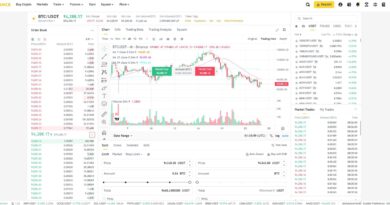Boltz Exchange Becoming The Leading Bridge Across Bitcoin Layers via “Holy Grail” Technology
Bitcoin Magazine

Boltz Exchange Becoming The Leading Bridge Across Bitcoin Layers via “Holy Grail” Technology
Boltz, the bitcoin-only instant swap exchange, is cornering a niche sector of the bitcoin industry and quickly becoming a favorite of advanced bitcoin users. Its fully open source tech stack, which is actually trust-less, unlocks a variety of possibilities for the industry, including a zero-custody risk bridge across Bitcoin layers.
Boltz exchange was founded in 2019 by Kilian and another pseudonymous co-founder, as a solution to managing liquidity in the Lightning Network for an early Bitcoin Defi project called OpenDex. Realizing quickly how complex lightning liquidity management was, the team ended up pivoting to the maintenance and polishing of Boltz, a liquidity service provider or LSP. Boltz has been self-funded ever since.
Boltz infrastructure supports multiple Bitcoin wallets today, such as BTCPay server via a plugin, Aqua wallet, Bull Bitcoin, and Breez, to name a few that are publicly known. As a result, Boltz is becoming an increasingly popular and respected company and open source project, an infrastructure cornerstone of Bitcoin’s Lightning Network today.
The Boltz Lightning node is one of the biggest, boasting on its website 759 Channels, 1022 Peers, 84.625 BTC worth of capacity, and 6.60 years since the oldest operating channel was opened, though these metrics are likely out of date. Their Lightning Network support lets advanced lightning node operators ‘balance their channels’ an otherwise complicated process that generally gets obfuscated away from end users of lighting powered Bitcoin wallets.
Boltz, however, is more than just an LSP; “We want to be the connecting tissue between all the Bitcoin layers.” Kilian told Bitcoin Magazine in an exclusive interview, discussing the vision and progress of the Boltz exchange so far. Initially built to support Bitcoin on-chain to Lightning Network swaps, today it supports Rootstock and the Liquid Network as well, the most popular ways of using bitcoin by far. To date, Botlz has only dealt in BTC, instead of integrating other blockchains or assets, perfecting its craft and locking in its niche.
In 2023, Boltz added support for the powerful and feature-rich Liquid Network, an open-source federated blockchain where federation members hold keys in a large Bitcoin multisig that collateralizes their L-BTC asset in full reserve. Liquid is one of the oldest two Bitcoin projects and was created by Adam Back and Blockstream. Despite having faster block times, a powerful set of programming scripts for smart contracts, and excellent privacy features such as encrypted transaction amounts on chain, Liquid has struggled to get adopted by centralized exchanges, making access to its feature set very difficult. Boltz integration opened a major bridge between on-chain bitcoin and the speed, programmability, and privacy of the Liquid Network, making wallets like Aqua and Bull Bitcoin possible.
Shy to share internal numbers, Killian told Bitcoin Magazine the integration “was quite the success story — it was taken on pretty well by the market, it just made sense for people.” Looking back on the market at the time, on-chain bitcoin fees were very high and were causing problems across the industry. Kilian noted, “We had a high fee environment. The main chain was hyper-expensive. So Liquid swaps clicked for a lot of people, and that’s how we really moved into this niche of connecting Bitcoin layers. A Bitcoin bridge for different Bitcoin layers, that’s really how this direction for us was fortified.”
In November of 2024, Boltz expanded into Rootstock support, a 2015 era layer two, little known among the English-speaking crowd, though very popular in Latin America, particularly Argentina, where many of its founders are from. Still shy to share internal numbers, Killian told Bitcoin Magazine that the integration with Rootstock has ‘gone well’, likely serving as one of the best ways to turn on-chain bitcoin into rBTC, an essential asset of the Rootstock ecosystem. Rootstock’s claim to fame is bringing to Bitcoin the integration of an Ethereum-compatible “EVM”, the smart contracting language on top of which most of DeFi is built across the crypto ecosystem today.
The most interesting feature of Boltz, however, is its use of Atomic Swaps, an ancient “Holy Grail” of Bitcoin theory that can be traced back to the earliest discussions in the Bitcoin Talk forum. Atomic Swaps make it possible for users to trade against Boltz without having to trust the Boltz team or company not to steal the money, a luxury in finance across history. All centralized exchanges require such trust, as do most instant swap exchanges in the market today. Boltz integration with this sophisticated type of smart contract means that anyone can fundamentally run a local instance of Boltz and be a reliable trade partner of the public, without the need to bootstrap a brand or a reputation.
But how do Atomic Swaps work? Leveraging the public nature of blockchains, Atomic Swaps function around a shared secret. This secret is used to lock the funds during the trade between two parties. For one party to claim the funds of the other, they must publish this secret to the blockchain, allowing the counterparty to do the same, resulting in the ‘atomic’ execution of the trade.
This protocol solves a key issue of trust in business. Who sends the money first? Who sends the goods first? Whoever does, takes a certain amount of risk as it allows the counterparty to take the goods and run. Atomic Swaps eliminate that risk entirely. They essentially allow for the creation of a non-custodial crypto exchange. Though the implementation details and user experience vary, as some blockchains do not have the right script or smart contracting tools to support Atomic Swaps, while fiat is — so far — ruled out entirely as bank transfers are almost always reversible, undoing atomicity.
Looking out into the future of Boltz and the programmability of Bitcoin as money for the digital age, Kilian said, “I think we will see a new breed of layer two projects launching early next year. So, probably stuff that you and I have never heard about, but there are so many projects, so much stuff. So this is a really interesting space to be in. And the difficulty, the quest, will be to separate the good from the bad.”
This post Boltz Exchange Becoming The Leading Bridge Across Bitcoin Layers via “Holy Grail” Technology first appeared on Bitcoin Magazine and is written by Juan Galt.
Bitcoin Magazine




















